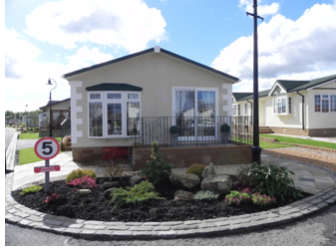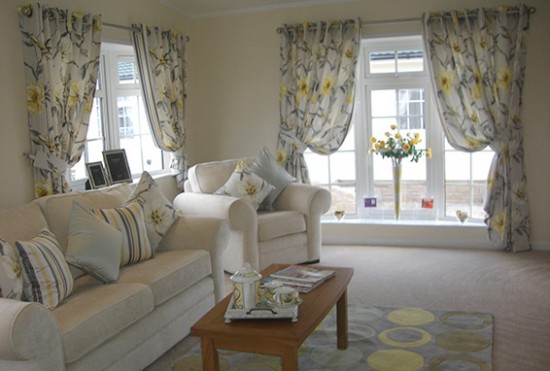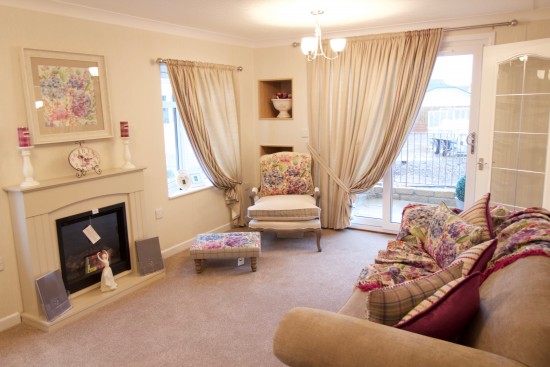How are Park Homes different from regular houses?
Apart from the way they are constructed, a park home looks and feels almost exactly the same as a conventional bungalow. Modern park homes have gas central heating, double glazed windows, pitched roofs. They are able to have all the regular services such as phone lines and cable TV.
Homes have a designated plot, generally with at least enough space for an outside patio area or garden.
In order to allow access to the underside of the home, it is usually raised 1-2 foot off the ground and surrounded with a brick skirting.
How much does a Park Home cost?
The value of a park home is reached when adding up two factors; the value of the home and the value of the land on which it is sited. The price of the home depends on the make, model, size and furnishings requested by the homeowner. This is often quoted as being the ‘un-sited’ or ‘ex-works’ price of the home.
The overall price of buying a park home, however, also needs to take into account the cost of siting the home and the value of the home once it is sited on the park. Once again, this depends on several factors, such as the location of the park (both its location in the country, and its nearby amenities), the size of the plot and position of the plot.
These two factors make up the overall cost of a Red Deer Village home. The best way to find out how much a certain home would cost would be to contact us directly on 0141 779 2973 for a quotation!
Do Park Homes hold their value?
Just as the cost of buying a Park Home is made up of two factors, so is the value of a Park Home. The value of the land on which the home is sited rises in line with regional property values and thus the value of the home increases. However, another factor to consider is that Park Homes have a finite life of about 50-60 years. As such, the actual value of the house depreciates over that time span, slightly counter-acting the rise in value of the land.
Historically, because land prices in the UK have risen for the last twenty years, the value of the land has risen faster than the homes themselves have depreciated. The value of sited homes has therefore risen over time, and is closely linked to the value of property in the local area. So there are very few park home owners who have lost money when buying a park home. And as Park Home living becomes ever more popular, there is an increasing demand for homes which acts to drive up prices. To see how Park Homes have risen in value over the past 20 years, please look at the park home living website.
How long do Park Homes last?
The manufacturers of all park homes on our parks are members of the NPHC (National Park Homes Council) and new homes are all supplied with a 10-year warranty. We have homes on our parks that are well over 40 years old and are still in excellent condition. Modern park home technology has improved dramatically over the past few years and modern park homes are expected to last beyond that figure with proper care and attention.
A new home is likely to require little maintenance in its first 10 years, other than external painting every 3 to 4 years. Older park homes do require maintenance, and a home over 20 years old may well require a new roof or re-cladding. Those interested in purchasing an older second hand home on one of our parks should consider carefully the maintenance requirements that will be required to maintain the condition of the home. We would recommend that anyone purchasing an older home, especially a home more than 10 years old, has a full survey of the property carried out before buying it.
Can I live in a Park Home all year round?
Yes, so long as the park has a permanent residential licence, you can use a park home as your main residence. Indeed, it is a requirement of most residential parks that the home is used as the home owners main residence.
Red Deer Village has a permanent Site License:
What are the monthly costs of living in a Park Home?
Homeowners pay a pitch fee, or ‘ground rent’, to the park owners for the plot on which their home is sited. This pitch fee varies from park to park, but is typically in the region of £120 – £175 a month. This pitch fee is for the right to keep the home on the particular park, and also covers maintenance of the communal areas, roads and such factors as electricity for streetlights and maintenance of the fire fighting equipment.
Other costs are much the same (or slightly less) compared to living in a bricks and mortar home. Council tax is payable on park homes, although this is usually the cheapest band, band A. Electricity is approximately half the price of a normal ‘bricks and mortar’ home, especially if the park buys electricity in bulk at commercial rates. Other services such a telephone line and satellite TV are purchased directly from suppliers such as BT or Sky.
Gas is sometimes piped in directly from the mains, depending on how far from a town or village the park is sited. If no mains gas is available, for example if the park is in a rural location, then LPG gas is generally used. On some parks, LPG gas is bought in bulk from suppliers and then piped to each home. LPG gas is more expensive than natural gas, and is one of the costs that is higher on residential parks than in traditional houses. However residents make a saving in other aspects such as the electricity so there is an element of one offsetting the other. Red Deer Village has all mains piped gas. Water is often metered and charged by the park based on consumption and rates approved by OFWAT. In some instances, water is supplied directly from the local water utility company. Red Deer Village is supplied with mains water and included in the council tax. Modern park homes are well insulated and can require less energy to heat than bricks and mortar homes. As such the amount of gas and electricity used compares favourably with that used in bricks and mortar homes.
Does the pitch fee increase each year?
Yes. The pitch fee is initially decided on in your agreement with the park owner. It will increase at the rate of inflation each year. It can be raised at more than the rate of inflation only if:
a) the park owner has invested in the park in the previous year in a way that benefits the residents and
b) the residents have been consulted on that improvement program.
c) the pitch fee is reviewed on 1st April in each year on Red Deer Village. The rules governing pitch fee increases are very strict, and they prevent the park owner raising the pitch fee in an arbitrary way.
Can Park Homes be resold?
Yes, Park Homes can be sold on the open market, although the new purchaser must comply with the Park Rules in force. This is especially important on residential parks where there may be a restriction on the age of prospective residents. Red Deer Village is exclusively for 50+ residents.
The park owner is entitled to a commission share of the sale, which currently stands at 10%. This figure is due to be reviewed and possibly amended in the near future. This transfer fee is not comparable with commission payments made to Estate Agents. rather it reflects the fact that the pitch and the amenities of the park add to the resale value of the home. It also reflects the fact that the value of the home is likely to have increased (because the land has increased in value) and the resident is paying the park owner for a share in that increased value. Transfer fees supplement the income the park owner receives from pitch fees and without them, pitch fees would have to be higher.
Since September 1st 2013, the 10% Commission fee has become the responsibility of the purchaser and should be deducted from the agreed purchase price of the home. this means that the occupier would receive 90% of the sale proceeds and the park owner would receive the other 10% of the sale price. If the 10% Commission fee is not paid to the owner then the assignment will be deemed not to have taken place.
Considerable investment is necessary to develop and maintain a licensed park home estate. A reasonable return on this investment is essential to ensure that the park continues as a viable concern in the interests of both the home owner and the park owner.
The homeowner is not required to tell the park owner that they intend to sell the home, however the homeowner may offer to sell the home to the park owner, although this is not a legal requirement, if the park owner is not interested in purchasing the home the Homeowner may enlist the help of a local estate agents or other marketing channels. However, Estate Agents’ fees are [payable on top of the transfer fee due to the park owner.
Can a Park Home be passed on in a will?
Yes, Park Homes can be passed on in a will. If it is left to a party currently not resident on the park, then they may only occupy the home if they meet the age restriction which on Red Deer Village is exclusively for 50+ residents. The Heirs may sell the home if they so wish.
If the home is left to the deceased’s husband or wife (living with them on the park) then the surviving partner can inherit the home and the rights for the home and continue to live on the park.
Passing the park home on to heirs includes transferring the agreement to the new owner. However, the 10% commission payable on the sale of a home does not apply when ownership is transferred due to inheritance, as no money has changed hands.
Do I own the plot/land?
No. You are granted a licence to use the plot with the home sited on it indefinitely. As the plots aren’t freehold properties, you never actually own them, you only hold the licence. However, you do own the actual home.
The licence lasts for the lifetime of the home, which by current manufacturer estimates is roughly 50-60 years.
Can I use a Park Home as my second home?
The short answer is no, a park home needs to be your “only or main residence.” This is not a park rule, but a legal stipulation in the Mobile Homes Act.
Holiday homes (or lodges), however, can only be used as your second residence and cannot be used as a main residence.
Are pets and children allowed on home parks?
This varies between parks, although the majority of our parks are for the over 50s and do not permit children to be resident on the park. This does of course make provision for children visiting for periods of time and it would be perfectly acceptable for residents to have, for example, grandchildren to stay for a period.
Most parks allow pets, although some only permit cats. All pets should be friendly and well-behaved and not cause a nuisance to other residents on the park.
For a full list of your rights and responsibilities, click on the link below:-
www.scotland.gov.uk/topics/built-environment/housing/privateowners/residentialmobilehomes


